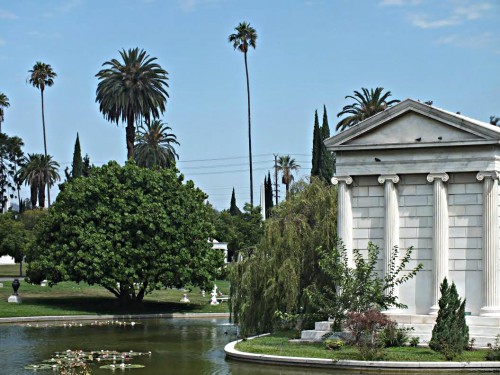Guest post by Celebrant Wendy Coulton of Dragonfly Funerals
Tinseltown is not immune to the universal challenges cemeteries face generating a sustainable income to maintain the grounds and run its services.
It was reassuring to learn as a former director of a charitable trust which manages Ford Park Cemetery in Plymouth that the Hollywood Forever Cemetery in Los Angeles has also been saved from the brink of financial collapse and closure. And the new owners have come up with innovative ways to get people through the gates to appreciate the cemetery as a heritage asset for all generations.
They have movie nights within the 60-acre grounds and kiosks with video tributes to people interred there.
I firmly believe that cemeteries must find such ways to make a connection with the living – to be relevant and resonate with people for different reasons – whether it is for the peace and green open space to reflect, the architecture and memorials or the abundant human interest stories. Cemeteries can capture the history, culture and individuality of a locality and its community just as well as any museum.
If you have a non-morbid love of cemeteries there is a name for us – Taphophiles.



Cemeteries are, of course, much more than just burial land. They are also libraries of memory and shrines of remembrance, as Wendy says. In the UK the popular image of a traditional cemetery will probably be based on a Victorian municipal facility on the outskirts of a town or city. It will have a landscape heavily dominated by gravestones and built memorials ranging from the simple to the flamboyantly ornate – not all in pristine condition. One of the founding fathers of such Victorian provision did not envisage that they would develop in that manner. John Claudius Loudon intended that… Read more »
I like ‘Ozymandias complex’ very much, Michael. Perfectly encapsulates it. ‘Shrines of remembrance’, you say. I’m not so sure. Some monuments and headstones commemorate famous men and women, but the majority, precisely because inscribed, seem thereby to perpetuate forgottenness. ‘You must have been somebody once, but sorry, I’ve never heard of you’. Loudon’s unmarked graves would at least have spoken of Everyman. In Woking there’s a great obelisk, symbol of Eternity, lying full length. Round the decay of that colossal wreck a wilderness of amnesia stretches in every direction. It’s now, to me at any rate, a salutary symbol of… Read more »
There are more people interred at Ford Park cemetery than alive in the city of Plymouth today. Fewer families make regular visits to graves than bygone days for various reasons and cemeteries need to find ways to engage with the wider public. At Ford Park children learn about childhood mortality in Victorian Plymouth and the impact of the Second World War on local people. It is an inspiring classroom. The cemetery is a green peaceful space for walks and contemplation and a wildlife haven. The restored chapel is a great venue for concerts and seasonal community events. So in a… Read more »
Interesting post, Wendy, and response, Michael. If cathedrals have gift shops attached, so too can more cemeteries perhaps explore funding ideas that attract visitors. Many attract walkers in the way that parks do, and some, such as Highgate, may have sufficient history and VIP occupants to justify a museum/museum shop/cafe. Space for events, such as film screenings or outdoor concerts, may be another option. Hard to know how Jo Public would perceive such initiatives.
We’ve used Ford Park Cemetery and found it delightful, full of interesting internees including, if I’m not mistaken, the marvellous Reverend Hawker of Morwenstow. Reverend Hawker was vicar of a Cornish village whose activities included wrecking, albeit of the passive unconscious variety. Rev Hawker buried hundreds of shipwrecked sailors, even giving full Christian burials to what he described as ‘gobbets of flesh.’ This harrowing life led him to take refuge in a hermit’s hut which still exists today, where he smoked opium to alleviate the horrors of the rural existence he and his parishioners endured. He also invented the Harvest… Read more »